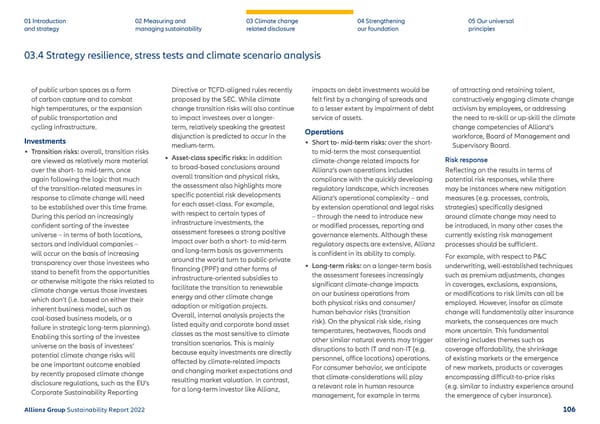03.4 Strategy resilience, stress tests and climate scenario analysis of public urban spaces as a form of carbon capture and to combat high temperatures, or the expansion of public transportation and cycling infrastructure. 01 Introduction and strategy 02 Measuring and managing sustainability 03 Climate change r elated disclosure 04 Strengthening our f oundation 05 Our universal principles Investments • Transition risks: overall, transition risks are viewed as relatively more material over the short- to mid-term, once again following the logic that much of the transition-related measures in response to climate change will need to be established over this time frame. During this period an increasingly confident sorting of the investee universe – in terms of both locations, sectors and individual companies – will occur on the basis of increasing transparency over those investees who stand to benefit from the opportunities or otherwise mitigate the risks related to climate change versus those investees which don’t (i.e. based on either their inherent business model, such as coal-based business models, or a failure in strategic long-term planning). Enabling this sorting of the investee universe on the basis of investees’ potential climate change risks will be one important outcome enabled by recently proposed climate change disclosure regulations, such as the EU’s Corporate Sustainability Reporting Directive or TCFD-aligned rules recently pr oposed by the SEC. While climate change transition risks will also continue to impact investees over a longer- term, relatively speaking the greatest disjunction is predicted to occur in the medium-term. • Asset-class specific risks: in addition to broad-based conclusions around overall transition and physical risks, the assessment also highlights more specific potential risk developments for each asset-class. For example, with respect to certain types of infrastructure investments, the assessment foresees a strong positive impact over both a short- to mid-term and long-term basis as governments around the world turn to public-private financing (PPF) and other forms of infrastructure-oriented subsidies to facilitate the transition to renewable energy and other climate change adaption or mitigation projects. Overall, internal analysis projects the listed equity and corporate bond asset classes as the most sensitive to climate transition scenarios. This is mainly because equity investments are directly affected by climate-related impacts and changing market expectations and resulting market valuation. In contrast, for a long-term investor like Allianz, impacts on debt investments would be f elt first by a changing of spreads and to a lesser extent by impairment of debt service of assets. Operations • Short to- mid-term risks: over the short- to mid-term the most consequential climate-change related impacts for Allianz’s own operations includes compliance with the quickly developing regulatory landscape, which increases Allianz’s operational complexity – and by extension operational and legal risks – through the need to introduce new or modified processes, reporting and governance elements. Although these regulatory aspects are extensive, Allianz is confident in its ability to comply. • Long-term risks: on a longer-term basis the assessment foresees increasingly significant climate-change impacts on our business operations from both physical risks and consumer/ human behavior risks (transition risk). On the physical risk side, rising temperatures, heatwaves, floods and other similar natural events may trigger disruptions to both IT and non-IT (e.g. personnel, office locations) operations. For consumer behavior, we anticipate that climate-considerations will play a relevant role in human resource management, for example in terms of attracting and retaining talent, c onstructively engaging climate change activism by employees, or addressing the need to re-skill or up-skill the climate change competencies of Allianz’s workforce, Board of Management and Supervisory Board. Risk response Reflecting on the results in terms of p otential risk responses, while there may be instances where new mitigation measures (e.g. processes, controls, strategies) specifically designed around climate change may need to be introduced, in many other cases the currently existing risk management processes should be sufficient. For example, with respect to P&C underwriting, w ell-established techniques such as premium adjustments, changes in coverages, exclusions, expansions, or modifications to risk limits can all be employed. However, insofar as climate change will fundamentally alter insurance markets, the consequences are much more uncertain. This fundamental altering includes themes such as coverage affordability, the shrinkage of existing markets or the emergence of new markets, products or coverages encompassing difficult-to-price risks (e.g. similar to industry experience around the emergence of cyber insurance). Allianz Group Sustainability Report 2022 106
 Sustainability Report 2022 | Allianz Page 106 Page 108
Sustainability Report 2022 | Allianz Page 106 Page 108